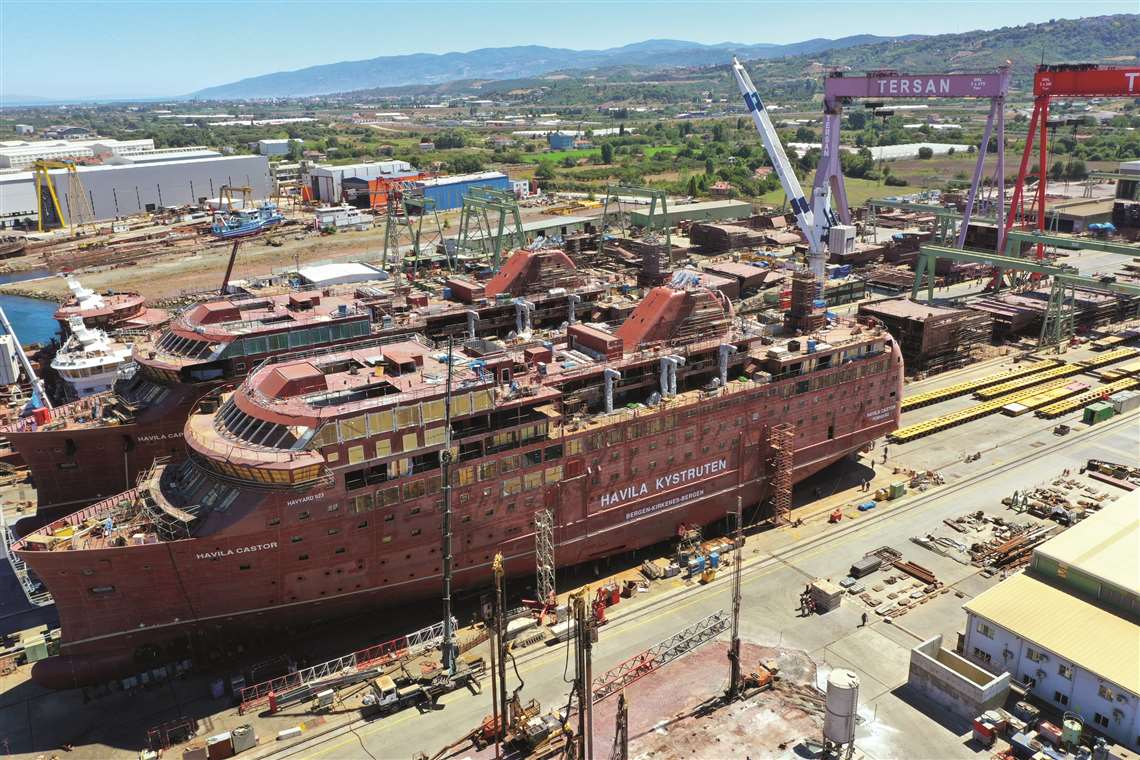SPMT: strength in numbers
09 March 2021
The flexibility and combined power of SPMT is key to its success, with end users using it to move increasingly large loads. Christian Shelton reports
Self propelled modular transporter when viewed in isolation, could be described as, well, petite; when axle lines are combined, however, these petite powerhouses sure pack a punch. And as the number of SPMT combinations and configurations available expands, there has been increased demand across a range of industries to move ever larger and heavier items and further too.
SPMT manufacturer Scheuerle, owned by heavy duty and special vehicle manufacturer Transporter Industry International Group (TII Group), says that the expansion of the renewable energy industry around the world is creating demand for its SPMT. This, it says, is particularly evident in the wind power sector, especially in North America, where tax advantages and government procurement goals have accelerated demand.
Part of the SPMT’s popularity comes from its versatility, Scheuerle says. Modules can be flexibly scaled in terms of their payload and coupling configurations. This means they are suitable for moving a wide range of wind turbine components. Onshore these components include rotor blades, star assemblies, hubs, tower segments, machinery housings and nacelles. For offshore, components also include anchoring equipment, transition pieces, concrete foundations, tripods and monopiles.
SPMT is also a safe way to transport cantilevered components and items with complex geometries or high centres of gravity, Scheuerle says, while its SPMT range can be coupled with axle lines from Tii sister company Kamag for further options.
The development of SPMT has seen the payload of heavy goods transport rapidly increase, Scheuerle states, with potentially unlimited payloads being possible. The company points to its record lift of more than 17,000 tonnes as evidence of the possibilities available. Their ability to operate in extreme climates is another plus-point adding to the popularity of SPMT around the world, Scheuerle adds.
Another factor in its popularity is its availability, Scheuerle says. The wide distribution of SPMT axle lines means procurement of the axle lines via its worldwide sales network is problem-free, the company claims.
Due to the widespread use across other fleets, axle lines can also be rented at short notice (cross-hire rental) in order to cover peak demands, it explains.
SPMT updates
In response to current market demand, Scheuerle has updated its SPMT range with new features. These include a redesigned, more compact remote control (RC) that weighs half that of its predecessor. Despite the reduced size, the new RC maintains full functionality with the same range (100 metres without obstructions). Instant radio signal provides precise positioning, says Scheuerle. Battery life has been increased from ten to 18 hours and the radio remote control doubles as a full cable remote control, so can be used in areas where radio is not permitted. In addition to Scheuerle’s SPMT, it can also be used to control the Tii Group’s self-propelled InterCombi SP/SPE and K25 SP/SPE series vehicles.
LED lighting has been incorporated into the RC’s safety guard to provide a good view of the device when working at night. A visual display in the remote control is available, providing function information and operating status.
The control system and electronics of the Power Pack Unit (PPU) have also been modernised. A 12 inch (300 mm) display shows more information, including the operating status of the drive, engine, cooler and the hydraulic oil level, says Scheuerle.
An additional measuring device for an input-output diagnosis is no longer required.
In-plant applications
The company is also expanding its PowerHoss SPMT series. The PowerHoss is a compact SPMT aimed at applications such as in-plant heavy goods logistics.
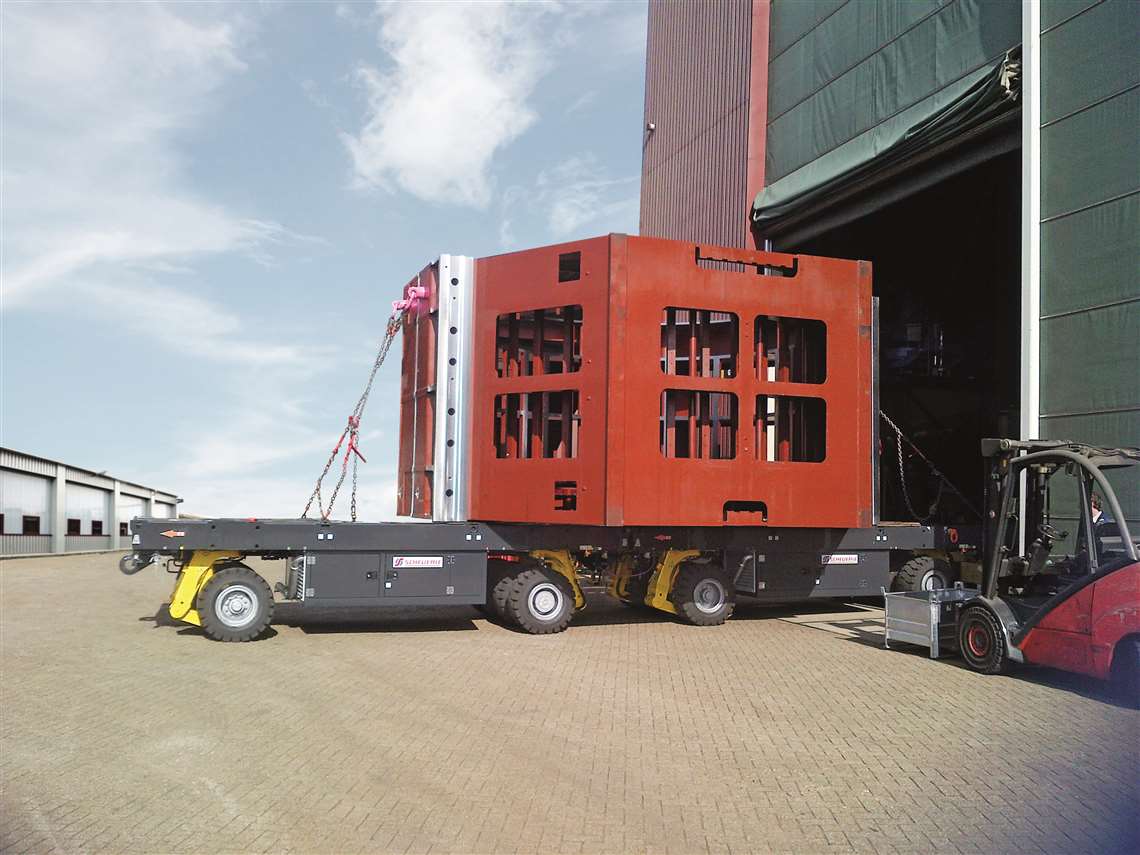 Scheuerle is expanding its PowerHoss SPMT series
Scheuerle is expanding its PowerHoss SPMT series
Until now the PowerHoss series has comprised vehicles with either two or four axle lines. A new version with six will soon be available to order, increasing payload capabilities up to 360 tonnes (when using polyfill tyres).
Individual PowerHoss modules can be operated either mechanically or electronically in a loose coupling mode as well as coupled to one another laterally or longitudinally. This, Scheuerle says, means it is well-suited to moving large and heavy machinery, equipment, components and other goods.
The additional axle lines also mean even greater stability. PowerHoss SPMT is available with diesel or electric drive at short notice, Scheuerle adds.
Another company making SPMT designed for in-plant applications is Cometto, part of the Faymonville Group. Its Eco1000 is the company’s latest SPMT. It is electronically steered and has an integrated Power Pack Unit for in-plant transport tasks up to a payload of 1,000 tonnes. The vehicle is easy and fast to configure, says Cometto. Three different power pack technologies are available: diesel; hybrid; or electric. According to Cometto, the SPMT can be configured as: 2-axle with two driven axle lines; 4-axle with two or four driven axle lines; 4-axle with two or four driven axle lines and long frame; or, 6-axle with four driven axle lines.
A steering angle of +135/-135° is for maximum manoeuvrability and precision using remote control. The hydrostatic drive system means the Eco1000 modules can be moved step-by-step and smoothly in all directions, says Cometto.
Larger loads
According to Scheuerle, the increase in payload capacity offered by the latest generation of SPMT is allowing industry to pre-produce and then move ever larger plant and installations. The advantage of this for hauliers and shippers is increasingly greater economic efficiency, Scheuerle claims.
To accommodate ever larger loads Netherlands-headquartered heavy lifting and transport specialist Mammoet, which has more than 3,200 SPMT axle lines in its fleet, has developed a widening adaptor that expands the width of its of split SPMT trailers from all 10 to 21 feet. It has also developed the TPA powered trailer system designed to improve transport efficiency and lower the carbon footprint of long haul projects.
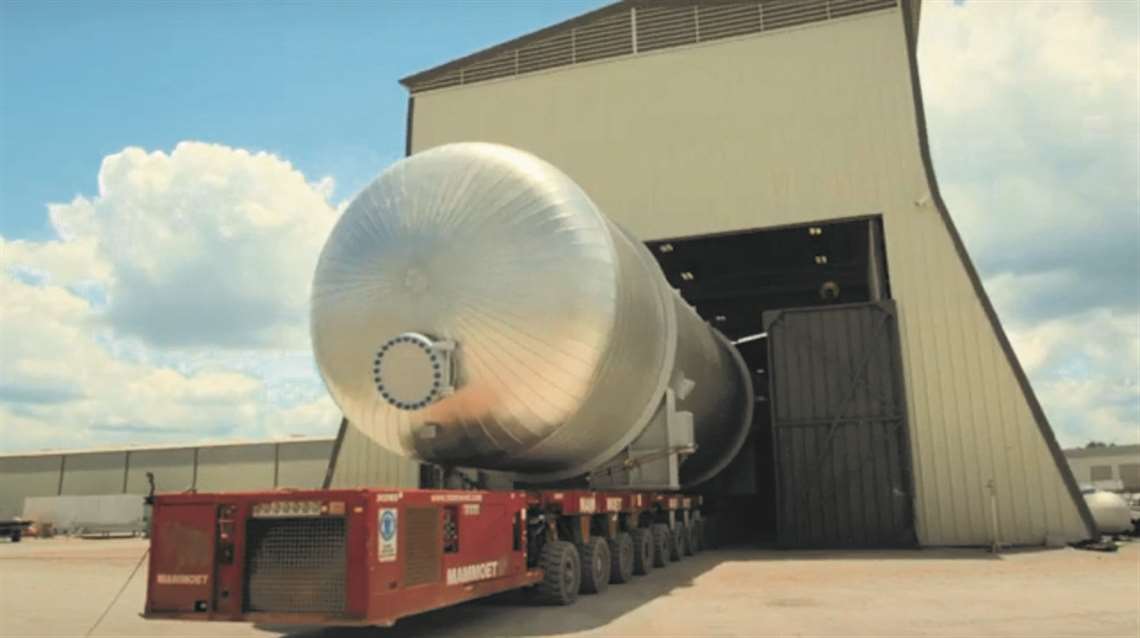 Mammoet used 24 SPMT axle lines to move a 235 tonne desalter vessel in Alabama. A video of the move can be seen here: www.shorturl.at/puJ17
Mammoet used 24 SPMT axle lines to move a 235 tonne desalter vessel in Alabama. A video of the move can be seen here: www.shorturl.at/puJ17
Mammoet’s Piet Nooren (VP technical director) and Ludo Mous (operations director), however, say there is a limit to demand for higher capacity axles for transports and load outs of super heavy offshore structures and super heavy lift cargo. “The roads and barges are not yet set up for these capacities,” they explain. “Typical barges can handle 10 tonnes per square metre. When handling higher loads, the tyres need to be foam filled and special rims are needed on the axles. 90 percent of these transport jobs go over gravel roads, and these roads don’t like hard tyres.”
Mammoet also points out the importance of accurately calculating the dynamic stability of loads. If, for commercial reasons, operators are forced to use their equipment at full capacity, Mammoet warns that, if not calculated correctly, it can result in unstable load positions. Because of the trend towards using higher trailer loads, Mammoet decided to examine the current calculation method, which has been used over the last 50 years. “We found that no dynamic force was considered in this calculation,” Nooren and Mous both state. “Because of this, we developed our own in-house EZTrailer programme which considers the dynamic force and can be changed to accommodate any specific trailer arrangement. This ensures that the calculation will be tailor-made. With the industry asking to maximise the capacity of the trailers, an accurate calculation which considers all factors is increasingly important.” The accuracy of Mammoet’s EZTrailer calculation has been confirmed by independent body DNV GL.
Mammoet is also working with DNV on the issue of SPMT maintenance. The company is concerned that SPMT more than 30 years old (where the state of maintenance is not known) are still allowed to be used at full capacity. Plus, there are no guidelines regarding how to maintain a safe trailer. “Mammoet is working with DNV in Europe in hope of developing stability regulations to increase safety across all industries and locations where SPMT is used,” Nooren and Mous say.
Offshore demand
To meet increased demand for heavy applications Cometto offers MSPE Evo3, which has a 70 tonne axle load capacity. Cometto reports demand in offshore plants in the oil and gas industries and shipyards.
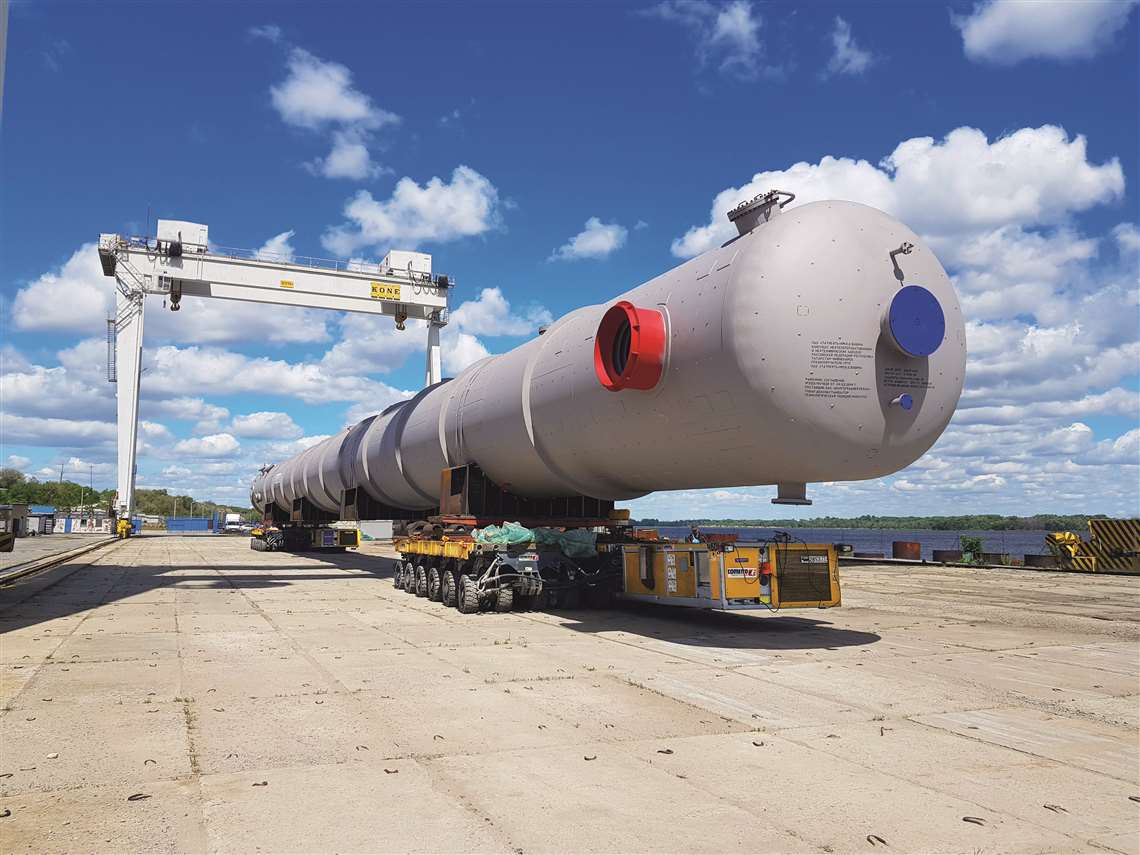 Spetstyazhavtotrans moved a 300 tonne deisobutanizer column using Cometto MSPE EVO2
Spetstyazhavtotrans moved a 300 tonne deisobutanizer column using Cometto MSPE EVO2
The MSPE Evo3 was used by Russian company Spetstyazhavtotrans, which specialises in shipping oversized cargo, to move a 300 tonne de-isobutaniser column. The column was 70.4 metres long and had a diameter of almost 5 metres. Two turntables and two simultaneously moving Cometto MSPE EVO2 SPMT with corresponding PPUs were used to move the column along a route that included curves up to 90 degrees, longitudinal slopes up to 12 percent and lateral slopes up to five percent.
From the above examples, we see the flexibility of the SPMT has led to demand for its capabilities from shipping, offshore, oil and gas, in-plant, and renewables sectors, amongst others. With such a spread of applications, the future of the SPMT mirrors that of its abilities: secure and stable.
Bridge removal in new brunswick, canada, with SPMT
Canada-based provider of heavy lifting and specialized transport services, Irving Equipment, was contracted by a Canadian telecommunications company to lift and move the Jones Creek bridge that crossed a tributary to the Saint John River in New Brunswick, Canada. The decommissioned rail bridge had become a liability to the telecommunications company, which decided to remove it.
Space to use a large crane was unavailable and a waterborne approach was ruled out due to insufficient water depth. Irving Equipment chose 12 lines of Scheuerle SPMT and a cantilevered lifting truss to remove the bridge, utilising the rail bed leading up to it.
Irving repurposed an existing 100 foot (30 metre) lifting truss as a cantilevered arm extending past the front of 12 lines of SPMT. Some structural modifications were required to allow the truss to be supported in this configuration. A pair of 2.75 inch (70 mm) Crosby turnbuckles along with two 55 tonne Straightpoint load cells located at the rear end of the truss allowed monitoring and adjustment of loads to stay within the design constraints.
12 Scheuerle SPMT axle lines and a cantilevered lifting truss were used to remove the bridgeFour 25 tonne JD Neuhaus air hoists were suspended from the underside of the cantilevered portion above specific pick points on the bridge being removed.
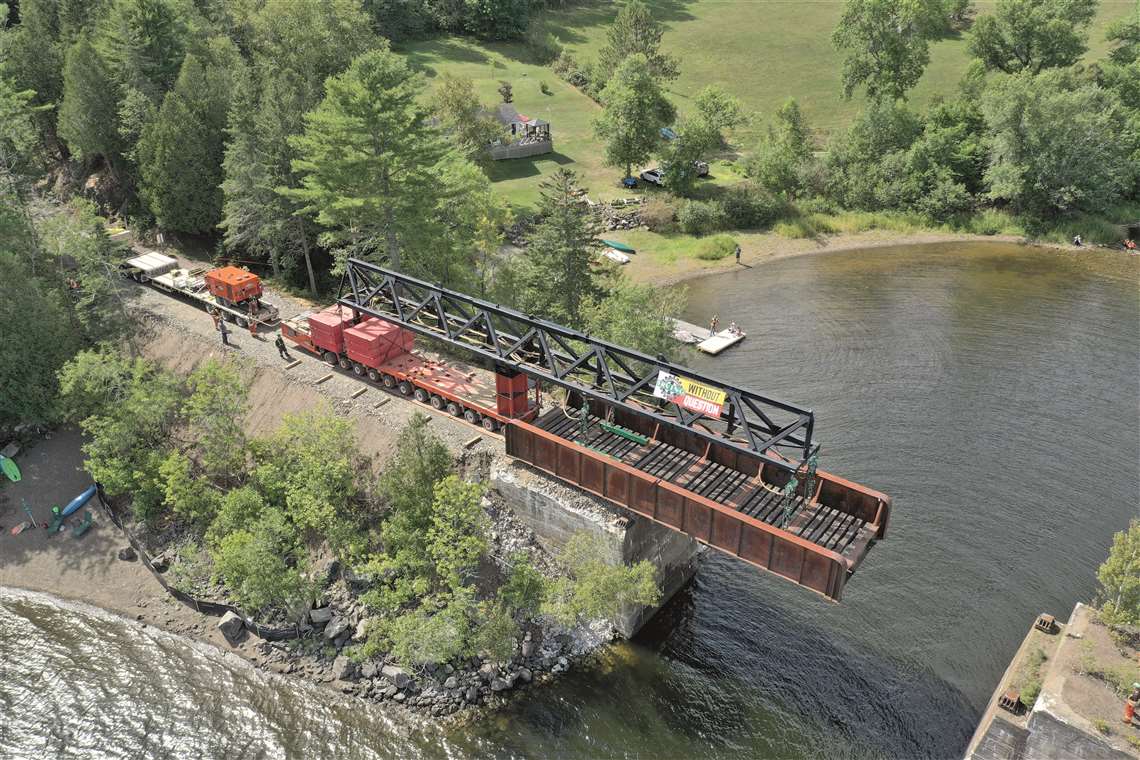 12 Scheuerle SPMT axle lines and a cantilevered lifting truss were used to remove the bridge
12 Scheuerle SPMT axle lines and a cantilevered lifting truss were used to remove the bridge
The air lines and hoist controls were routed internally down the length of the truss to keep the operator a safe distance from the equipment. 120 tonnes of counterweight was used in strategic locations to maintain the stability of the hydraulic suspension of the SPMT.
Irving assembled the components at its yard where it performed transport and load tests to 125 percent of the estimated load weight. With a green light from a third party inspector, the components were disassembled and trucked to the bridge site 25 miles (40 km) away.
The laydown area for reconstructing the SPMT assembly was 325 yards away, and at an elevation 35 feet higher than the bridge site in a farmer’s field. Irving’s sister company, Gulf Operators, performed the civil work and constructed a ramp with a 14 percent grade down to the rail bed. With the majority of the components installed on the SPMT, half of the counterweight was placed toward the front of the deck to aid stability in a three-point suspension configuration as the assembly was moved down the steep slope.
Once at the bottom, the air hoists were attached to the underside of the truss and the front stack of counterweights were moved back toward the rear of the deck to act as ballast to counter the weight of the bridge during the lift. The SPMT suspension was then changed to a four-point suspension configuration.
At this point the SPMT were ready for lifting and positioned at the abutment of the bridge, with the cantilevered truss and air hoists above the bridge.
Once the hoists were connected to the bridge, Irving followed a communication plan between the SPMT operator (tasked with monitoring suspension field pressure gauges), hoist operators, and lift director that monitored load cells connected at each pick point, in a coordinated effort to stay within design parameters. As the bridge was lifted clear of the bearings and surrounding terrain, the whole assembly was rolled backward until the bridge was able to be safely lowered onto awaiting cribbing.
In total, the job took three days from arriving on site to leaving.
A video of the project can be seen here: www.vimeo.com/459413104
Turkish heavy lifting and transportation service provider Hareket Heavy Lifting & Project Transportation moved two 6,200 tonne passenger ships over a distance of 250 metres to a floating dock at the Tersan Shipyard, Yalova, Turkey.
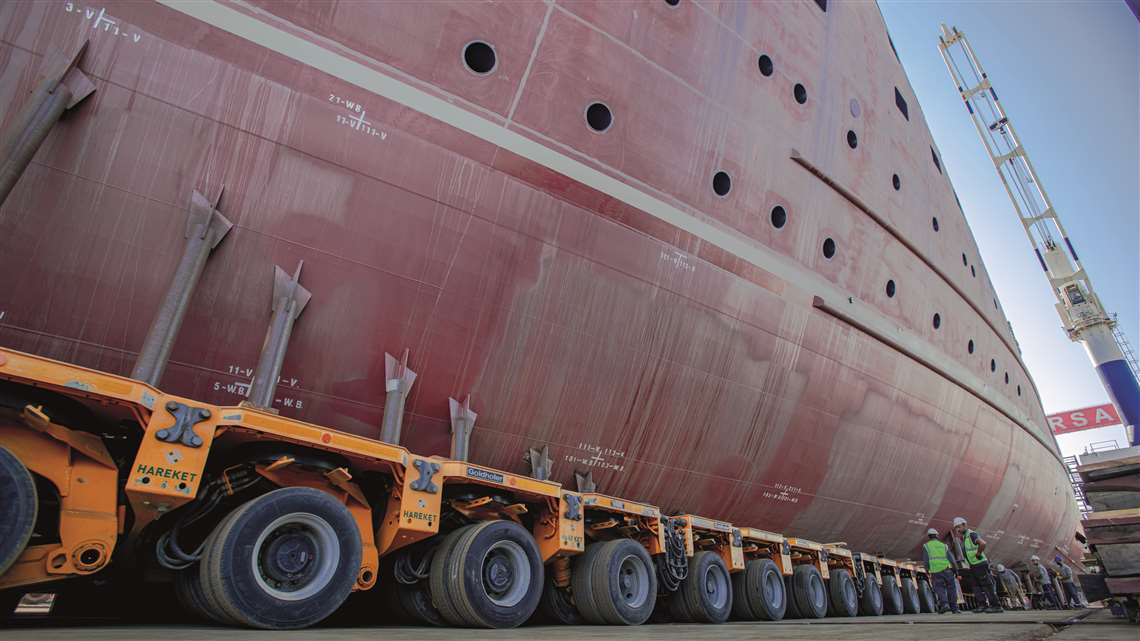
To move the ships Hareket used a total of 200 heavy duty axle lines with 1,600 wheels. The equipment included 56 Goldhofer PST/SL-E heavy duty modules with hydrostatic drive and electronic multiway steering, plus 36 Goldhofer conventional THP/SL heavy duty modules. It took Hareket four days to relocate the two ships in the floating dock with a space of just 1.5 metres between them.
